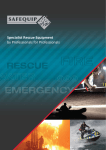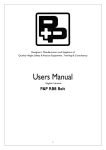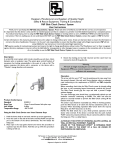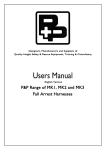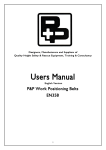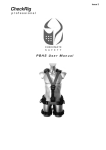Download P&P Full Body Sit-in Harness
Transcript
USERS MANUAL For English speaking countries only P & P Full Body Sit Harness Thank you for purchasing this P&P F u l l B o d y Sit Harness. Please take time to familiarize yourself with the correct attachment, positioning and adjustment procedure. It is imperative that this P&P Full Body Sit Harness is only used for its intended purpose and that it is subject to a periodic recorded detailed inspection by a competent person. To avoid personal injury, prior to using this P&P Full Body Sit Harness or training others to use it, CAREFULLY READ and understand these instructions. If there is anything you do not understand, DO NOT use this P&P Full Body Sit Harness, contact the supplier or P&P for further details. Certain information in this manual is governed by law and is subject to change without prior notice. Great care has been taken to ensure that the information is correct at the time of publication. However, it is the user’s sole responsibility to ensure that they fully comply with all legal requirements. P&P will not accept liability for any inaccuracy or incorrectly stated legal requirements. P&P operate a policy of continual improvement and reserve the right to change specifications without notice. The Manufacturer and / or their recognised agents, directors, employees or insurers will not be held liable for consequential or other damages, losses or expenses in the connection with or by reason of or the inability to use the P&P Full Body Sit Harness for any other purpose. Note; training should only be delivered by a suitably qualified and competent person, ie a P&P products trainer. Introduction: The P&P Full Body Sit Harness has been designed for your safety, and will provide comprehensive protection whatever your situation. The harness is designed to support the body and distribute force to prevent serious injury in suspension work and fall arrest. In the event of a fall it will keep the worker in a safe position ready for rescue. This harness must only be used in conjunction with an energy absorber or force limiting device. Maximum all up weight 150kG. Recommended anchorage strength 15kN. Fall Arrest: Certified fall arrest points are clearly marked with an “A”. The rear “D” is your primary attachment point. Although the front “D” connection is permitted for fall arrest it is primarily for work positioning and close connections, such as ladder climbing and rescue. Work Positioning: Side “D” rings are for work positioning only, and not fall arrest. Suspension: The front suspension “D” is to be used for suspended work and when used as a sit harness. Ascender/CROLL attachment: The P&P Full Body Sit Harness is supplied with two front attachments for attachment of a CROLL ( n o t s u p p l i e d ) or similar EN567 ascending device. Refer to the device instructions for full user instructions. Suspension Seat Attachment: Two loops located near the front suspension “D” allow the user to safely connect to a suspension seat. Warning Suspension seat attachments must not be used for fall arrest or work positioning purposes If in doubt please clarify application with P&P technical support. 1 Shoulder Adjustment Leather Neck Protector Rear Fall Arrest “D” (not visible) Shoulder Straps Elasticated Strap Holder Front Fall Arrest “D” Click Lock Buckle Attachments for CROLL Waist Belt Work Positioning Side “D” Attachment for Suspension Seat Front Suspension “D” Adjustable Rear Leg Extensions (not visible) Leg Loops Leg Adjuster & Click Lock Buckle Storage, Issue & Inspection Storage Storage in a centrally located protected area allows the assurance of inspection on issue and return. This harness should be stored in a clean dry place where it can be protected from damage by chemical attack, sharp objects, heat and direct sunlight. It should be stored with its instructions and record card at all times. If the harness is wet, ensure it is left to dry naturally before storage. After use return to the store, never leave a harness lying around site. Issue This harness and associated equipment must be visually inspected by a competent person when first delivered to site, thereafter check your harness and associated equipment for any damage or malfunction prior to each and every use. If there is any doubt about the safe condition of the system, it should be immediately withdrawn from use and inspected by a competent person or returned to the supplier/manufacturer. The product name, unique serial number and date of manufacture will be found on the product label. Always ensure the product label is present, shows both the serial number and date of manufacture and that it matches your inspection Record Document/this manual. If the Product Label numbers are not legible or do not match your inspection record document/this manual – Do not use the harness. Detailed Recorded Inspections should only be carried out by a competent person, appointed by the employer. Additional, recorded interim inspections may be required where risks from transient arduous working conditions exist. This should be identified through risk assessment. These recorded inspections must be carried out at least every 12 months as a requirement of EN365; however in the UK the HSE would like all fall prevention PPE to have a Detailed Recorded Inspection every 6 months. Inspection Webbing - ensure that the webbing is free from cuts, abrasion, wear and tears. Special attention should be given to the webbing under each and every buckle for rubbing and general deterioration. Check that the weave of the webbing is even and shows no sign of distortion or “necking” resulting from loading. Buckles - check for damage, distortion. Surface coating should be clean and show no sign of corrosion. Sewing - Look for loose or damaged threads and uneven stitch pattern. if any feature shows cause for concern remove the unit from service immediately, mark the harness as unserviceable and return to the supervisor. No repairs, modifications or alterations are to be carried out on this P&P Full Body Sit Harness. Environmental Hazards This product is manufactured from polyester throughout and is therefore susceptible to wear, abrasion, cuts, melting and chemical attack. Always inspect the full length of the webbing before and after use. In environments where acids, alkalies, phenolic compounds, and heat are present special care should be taken when inspecting the integrity of the webbing. Cleaning Clean equipment regularly with a mild detergent and water, allow to dry naturally. A clean harness is easier to inspect and will last longer. 2 Fitting Hold harness up by shoulder straps and check webbing is not twisted. Loosen leg and waist belts if necessary to ease fitting. Unfasten front click lock buckle, and lay shoulder straps behind waist belt. Step through Waist belt and leg loops. Pull harness up over waist, and tighten waist belt and leg loops. Pull shoulder straps over your head, ensuring the rear strap and shoulder straps are not twisted. Fasten the front click lock buckle. Adjust all webbing so that the harness fits comfortably without restricting free movement or pinching. Adjust dorsal so that it is between shoulder blades and within reach. A rear dorsal that is too high or too low will cause the body to take an undesirable position during a fall arrest situation. Before use as a sit harness, carry out a suspension test in a safe place to ensure the sit harness is the correct size, has sufficient adjustment, is adjusted correctly, and is of an acceptable comfort level for the user. CROLL attachment: To attach, connect as shown between the two front deltas on the harness. The top link is orientated with the long side horizontally. Ensure both Rapide links are nipped with a spanner to ensure they do not come undone. Refer to the device instructions for full user instructions and correct orientation. Anchorages The supervisor must ensure that there are sufficiently strong and accessible anchorage points in the working environment to ensure that all personnel can work safely. All anchorage points should be inspected regularly to assure they are robust and strong enough to withstand a force of 15kN. Anchorages should be above head height when possible and the area beneath and around these anchorage points should be clear of obstruction and sharp edges. The wearer of the harness should attempt to attach to an anchorage that is as close to the point of work and as high above head height as possible without restricting free movement. The wearer should be aware at all time of which point of attachment they should use. If this is not immediate obvious they should seek confirmation from the supervisor. Always ensure that the means of attachment to the anchorage is secure before moving off. Rescue and Risk Assessment Suitable planning and risk assessment should be carried out by the user and or a supervisor. A suitable rescue plan should be in place to minimise post fall suspension time. P&P can offer a complete range of rescue equipment to suit your requirements. Compatibility This harness is only suitable for use as described in the manual for fall protection when used in conjunction with a means of tie off that limits forces upon the harness and the anchorage to 6kN. 3 Product Standards The P&P Full Body Sit Harness has been designed to meet the requirements of EN361:2002, EN813:2002 and EN358:1999 Marking of PPE Textile products including webbing and rope must not be marked using ink or paint. Marker pens and paint will contaminate textile fibres leading to potential damage from material stiffening or even chemical attack. Plastic or Metal casings of components must not be marked by stamping, etching or engraving. These processes may weaken the material or damage protective coatings. P&P advise that if additional identification is required, a tagging system (label or electronic) should be used, that does not interfere in any way with the operation of equipment or devices. Contact P&P or your supplier for advice on additional labelling. Statement of Obsolescence Due to the ingress of dirt and grit, chemical contamination, edge and surface damage, ultraviolet light degradation, and wear and tear, Fall Protection Equipment manufactured from synthetic fibres (webbing and/or rope) is subject to a manufacturer’s statement of obsolescence, which is a requirement of BS EN 365:2004 a European Product Standard. Any item of Fall Protection Equipment manufactured by P&P with synthetic fibre components (webbing and/or rope) is subject to maximum life span of 10 years from date of manufacture, provided that the item has been correctly stored, maintained and subjected to regular recorded inspections by a trained and competent person. However, if the item fails any inspection, it MUST immediately be withdrawn from service and destroyed. An item of Fall Protection Equipment incorporating synthetic fibre components (webbing and/or rope), manufactured by P&P from January 2015, which has been subject to a lifetime recorded inspection plan, may give a maximum life span of 10 years. The lifetime recorded inspection plan must be continuous from date of first use and be undertaken by a competent person appointed by the employer. Competent persons must be trained in the use and inspection of the equipment. The lifetime inspection plan must include as a minimum requirement, a pre use check and 6 monthly recorded inspections. The frequency of inspections should be determined by risk assessment, use and environmental conditions. Reference should also be made to the British Standard BS 8437:2005 – ‘The code of practice selection, use and maintenance of personal fall protection systems and equipment for use in the workplace’ - clause 13.2 Lifespan, which states: ‘Some equipment is given a life span or obsolescence date by the manufacturer. Equipment that has reached such a limit, which has not already been rejected for other reasons, should be withdrawn from service and not used again, unless or until confirmed by a competent person, in writing, that it is acceptable to do so.’ It should be noted that inspections carried out by a trained and competent person are only visual and tactile observations of the condition of the product; they are not testing the residual strength of the equipment. All synthetic fibres deteriorate slowly with age regardless of use and as a result, P&P strongly advises all users of Fall Protection Equipment to follow the manufacturer's statement of obsolescence. For further advice on this statement, as well as training in the use and inspection of Fall Protection Equipment, please contact P&P EC Type Approval SGS United Kingdom Limited, Unit 202B, Worle Parkway, Weston-super-Mare, Somerset BS22 6WA P&P Safety Limited, 131 New John Street, Aston, Birmingham B6 4LD, England. Telephone: 0121 359 4561 Facsimile: 0121 359 4136 Email: [email protected] Website: www.ppsafety.co.uk P&P Full Body Sit Harness V3_0615 All rights reserved. No part of this publication may be reproduced, stored in a retrieval system, or transmitted, in any form or by any means, electronic, mechanical, photocopying, recording or otherwise, without the prior permission of P&P Limited. P&P Safety Limited, 131 New John Street, Aston, Birmingham B6 4LD, England. Tel: +44 (0)121 359 4561 Facsimile: +44 (0)121 359 4136 e-mail: [email protected] website: www.ppsafety.co.uk Registered in England No. 01493537 4





